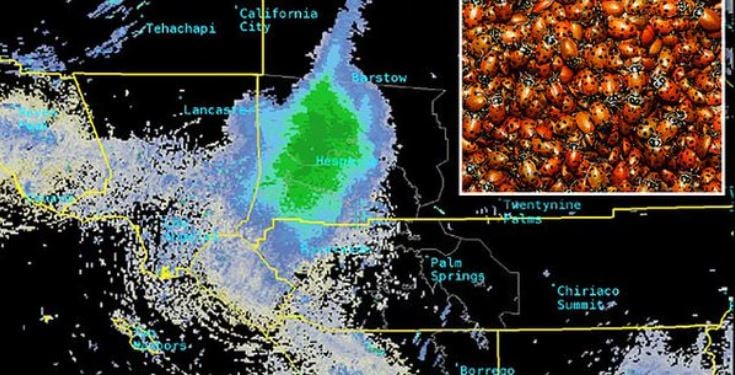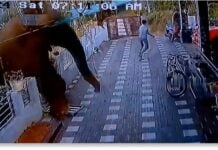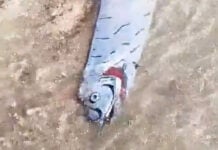A California ladybug swarm was so big it showed up on a radar as a 80-mile-long bloom.
The San Diego branch of the National Weather Service tweeted that a large “echo” which appeared on the SoCal radar wasn’t rain, but in fact “a cloud of lady bugs.”
This phenomena is known as a “bloom,” according to the National Weather Service San Diego.
The large echo showing up on SoCal radar this evening is not precipitation, but actually a cloud of lady bugs termed a "bloom" #CAwx pic.twitter.com/1C0rt0in6z
— NWS San Diego (@NWSSanDiego) June 5, 2019
National Weather Service meteorologist Miguel Miller meanwhile told local radio station KNX the bloom appeared on screens as 80 miles long and wide. It was traveling from the San Gabriel Mountains to San Diego.
The blob was pictured moving from the city of Barstow in San Bernadino County 80 miles south to Riverside, a city near Los Angeles. It covered an area of more than 1,000 square miles in total.
A weather spotter in Wrightwood in the San Bernardino mountains reported a higher than usual population of ladybugs. The weather service then linked the mass to this sighting.
There weren’t a lot of clouds in the area at the time the blob appeared. “This radar return was much larger than what those clouds could’ve been producing,” she said.
The patch headed southward on Wednesday morning, and disappeared from screens by noon. It was unclear where the insects were traveling from or to.
Really?
However, one expert was skeptical that a loveliness (the collective noun for the insects) of ladybugs could show up so strongly on a radar map.
James Cornett told the Palm Springs Desert Sun that the number of bugs needed to create such movement on equipment would have turned skies dark.
The insects are known to come together in large groups in winter and fall, but in the thousands, not tens of millions, he said.
Cornett said: “There would have been unbelievable numbers of telephone calls to the police. It merits some investigation.“

However, NWS San Diego Joe Dandrea meteorologist explained the insects weren’t grouping but rather spread out. The bugs were believed to have been flying at between 5,000 and 9,000 feet. One segment is thought to have spanned 10 miles wide.
Dandrea said: “I don’t think they’re dense like a cloud. The observer there said you could see little specks flying by.“
Cornett went on to argue that ladybugs generally head north for food during the spring season, not south, don’t tend to travel far, and their heavy wings likely wouldn’t allow them to fly high enough to be picked up by radar equipment.
Cornett said the phenomenon was “unusual.” He joked: “The world must be coming to an end.“
There were no big storms in the area… Oh my lady bugs!
[Newsweek]











